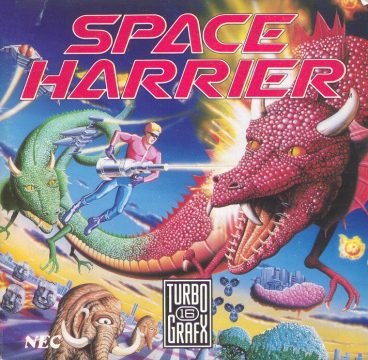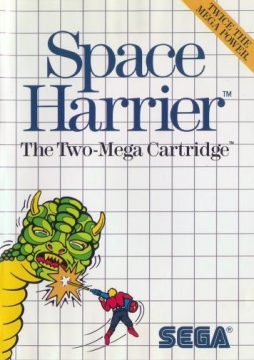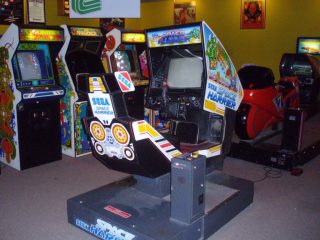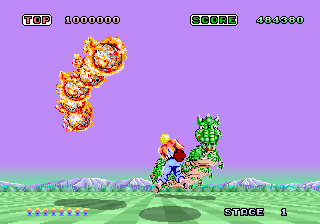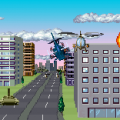Released by Sega into the arcades in 1985, and designed by the legendary Yu Suzuki, Space Harrier is a shoot-em-up that ditched the horizontal or vertical views of most games at the time, and put the viewpoint right behind the player. Featuring a flight stick to emulate piloting a jet fighter, players take control of the “Harrier“, a blond guy wearing a red shirt and blue pants.
Through means left entirely unexplained, the Harrier can fly over the landscape at incredible speed. Armed only with a huge cannon, he rushes forward, destroying the bizarre, dangerous creatures of Dragon Land. It wasn’t the first game to use this technology – Space Harrier is predated by Sega’s own 1982 3D shooter Buck Rogers: Planet of Zoom – but it’s a huge technological improvement, and manages to look extremely impressive even today.
The action is remarkably simple: just fly, dodge, and shoot back. Even though there’s no targeting crosshair, aiming is remarkably easy, as you only need to shoot in the general vicinity of a foe to hit them. Bad guys also shoot directly at the Harrier, so as long as you keep moving and don’t backtrack over your previous position, you won’t get hit. All the while, you’ll be maneuvering the Harrier between stone columns, stationary poles, and various kinds of plants. While you’ll usually only trip over bushes and rocks, smacking into a tree spells certain death (the original arcade release also has a glitch where you’ll shoot right through bushes, though most later ports fix this).
The trippy backgrounds are a trademark of Space Harrier. The ground consists of a flat checkerboard which changes color every stage. The sky switches between from bright blue to the yellow of dusk, to the pink atmosphere of some otherworldly planet. Across the horizons are alien buildings and landscapes which fall and rise after the completion of each stage. A few levels even feature a ceiling, giving a hallucinatory feeling of claustrophobia. There are 18 stages total.
The enemies in Dragon Land are extremely creative and distinctive. The Harrier fights one-eyed mammoths, bulbous yellow squids, stone heads, and orbs that resemble cybernetic peanuts. Amidst all of the bizarre enemies are more standard types, like jets and flying mecha (which are basically the Doms from Mobile Suit Gundam), although even these designs are still incredibly cool looking. But the most impressive foes are the dragons, usually taking the role of the level boss. Each of these consists of a head and several segments which, in motion, gives the appearance of long, floating Chinese dragons. Their visage is reminiscent of Falkor the Luck Dragon from the movie The Neverending Story.
Keeping control over the Harrier, all while dodging and firing amidst the wild colors, is the kind of glorious chaos that is representative of the best in 1980s arcade gaming. The stages have strange names like Moot, Geeza, Minia, Parm and Absymbel, that help create a distinctive and thoroughly memorable game world. There are also a few bonus stages, where the Harrier hops on the back of a white dragon named Uriah. Although he’s hard to control, Uriah is invincible, and the goal is simply to smash as much of the landscape as possible.
Space Harrier’s theme song is incredible, composed by famed Sega musician Hiroshi Kawaguchi, and easily ranks as one of the most memorable in gaming. It only fades out during boss fights or special stages, but it’s long enough that it never gets tiring. There’s also the encouraging voice over, which yells “Welcome to the Fantasy Zone! Get Ready!“ or proclaims “You’re doing great!“ after the end of each level. Even after dying, as your Harrier screams in agony and falls to the ground, a friendly message pops up that says “Many more battle scenes will soon be available!“ as he picks himself off the ground and returns to battle.
Given its popularity, it’s natural that Space Harrier would be ported to every possible platform. Unfortunately, given the advanced hardware of Sega’s bespoke Space Harrier arcade board, there was no home system at the time that could pull off the scaling effects necessary to replicate the sense of speed found in the original. Not only that, but the analog control needed to be ditched in favor of digital, which greatly alters the gameplay.
The first console port was to Sega’s own Master System. The pace had to be stifled quite a bit for the 8-bit machine to keep up, and the scrolling is much choppier. Still, the huge enemies manage to impress. For the most part, the enemies and levels are comparable to the arcade version. Sega added an additional final boss named Haya-Oh (named after Hayao Nakayama, the then-president of Sega) and a real ending – which is much better than the arcade version, which simply showed up a huge “The End“ sign. Also hidden is the ability to play as a jet fighter and a secret message that urges players to write to Sega giving their opinions.
The Game Gear port is based on the Master System release. Due to the smaller screen size some of the proportions had to be changed, so the Harrier is much bigger. The enemy sprites have been altered to appear more organic. Some of the level names have been changed as well, and there are only 12 stages in total. A password function also allows players to skip to later levels. Despite running on the same hardware as the Master System, the music has been rearranged.
Takara ported Space Harrier to the Famicom. While the scrolling is smoother than the SMS port, the Harrier moves incredibly slowly. There’s a whole bunch of flicker, and all of the sprites are smaller. They couldn’t even fit any of the voices in. The enemy arrangement is based on the Master System version, so it has the additional final boss.
NEC Avenue and Dempa brought Space Harrier to the TurboGrafx-16. It’s smoother than the other 8-bit console ports, but it still doesn’t feel quite right, and it both looks and sounds ugly. The checkerboard floor is also gone.
Dempa also took care of the computer ports in Japan. The versions on the PC-6001 and the PC-8801 are the worst looking iterations out there. While the Harrier is a low-color sprite (as are the enemies in the latter version), everything else, including the clouds, trees and bullets, are just featureless colored rectangles. And yet despite how awful it looks (or perhaps because of this), it keeps up the speed, and actually plays more smoothly than most of the European computer ports.
The Sharp MZ-700 and X1 conversions are slight steps up, though most everything still looks like colored blotches. The Fujitsu FM-7 version looks decent and plays alright. The X68000 port is by far the best of these, with smooth animation and almost completely faithful gameplay, though the checkerboard floor has been removed in favor of scrolling bars. All of these computer versions have slightly different but excellent soundtracks. The X68000 version features Haya-Oh, the SMS ending, and a new credits sequence, along with two new music tracks.
Elite handled the home computer ports for Europe and North America. The version for the Commodore 64 is too fast and choppy, though the music is decent. The European version is slightly better, being that the floor has a scrolling effect, whereas it’s just a solid color in the American release. The ZX Spectrum version is sluggish and hideously colored. The Amstrad version looks nicer, though while the Harrier is a detailed sprite, the enemies and objects are simple wireframes.
The IBM PC version looks alright, but the animation is still very choppy, and the speed feels off. The Amiga and Atari ST versions are the best of these, with faithful graphics and good animation which isn’t quite as smooth as the arcade version, but far more playable than its brethren. However, due to the size, it had to be split into two separate games – Space Harrier and Space Harrier: Return to the Fantasy Zone.
It wasn’t until the 32X in 1992 that Space Harrier finally came home in nearly arcade perfect form, but it only runs at 30 FPS. The Saturn version was released five years later as part of the Sega Ages line, and is very nearly arcade perfect. It came out on a single disc in Japan, and was bundled together with OutRun and After Burner II for the Western release. It includes true analog control to mimic the original arcade game.
Space Harrier is also playable in both Shenmue titles for the Dreamcast and Xbox. It’s missing some of the customization options of the other ports, but if you can beat the game in one credit, you get a certificate from the arcade owner in the first Shenmue. The Game Boy Advance version was featured as part of the Sega Arcade Gallery collection, ported by Bits Studio. Although it looks fine on the outset, it’s badly programmed, and just doesn’t feel right.
Space Harrier saw a remake on the PlayStation 2 under the Sega Ages 2500 series. The entire game has been redone with polygons, but the whole makeover looks rather cheap, with jaggy visuals and low resolution textures. The redesigned look of the Harrier is lousy, with his silly goggles and spiky blond hair. The graphics lose much of the bright color that made the original so attractive, but since the objects here are actual 3D objects instead of 2D sprites, it gives a better impression of depth and scale. In the original game, all of the boss dragons were made out of individual segments that scrolled in unison, giving the illusion of a flying beast. Here, they actually look like dragons. There’s no option for analog control, sadly.
The remixed music tracks are quite good, and the new announcer spouts more ridiculous phrases, like “Get busy, Harrier! Dragon Land is screaming!“ There’s also now a lock-on laser similar to Panzer Dragoon, along with a limited-use rapid fire button. You can also get bombs to clear the screen, but these make the boss battles far too easy.
The new “Fractal Mode“ turns off the classic checkerboard pattern and replaces it with a texture map, which looks pretty ugly. It also changes certain parts of the level so you can’t run on them and need to fly. Additionally, there are a few extra tunnel stages, where you zoom through an enclosed tube. These would have been cooler had they not pasted the same low-res textures on the walls. Both the PS2 and the Japan-only Sonic Cafe mobile releases change the robots to look less like Doms.
There are also arcade-perfect ports available on the Space Harrier II Complete Collection for the PS2, and on the Wii Virtual Console, the latter of which features analog control by tilting the nunchuck. It’s also unlockable in Sonic’s Ultimate Genesis Collection for the PlayStation 3 and Xbox 360, but the scaling effects are dodgy, and the audio is too high pitched.
In 2011, a hobbyist programmer named Chris Hutt ported Space Harrier to the Atari 8-bit computers. It’s a true work of art, because it’s better than the official computer ports that came out in the 1980s, with excellent visuals, fast action, and smooth gameplay. It is free to download.
3DS HAYA-OH GOES HERE
In 2012, 3D Space Harrier was released for the 3DS. Ported by M2, it features outstanding 3D visuals and widescreen. There’s a mode to simulate the moving cabinet of the arcade game that tilts the screen back and forth, complete with simulated gear noises. Also included is a stage select and Haya-Oh as a hidden final boss, along with a new track by Manabu Namiki for the final battle. The Dom enemy has also been renamed Varel, but their design has not changed. The revised version on the Sega 3D Fukkoku Archives cart includes enhanced 3D effects and bug fixes.
ADD: Other C64 (if it exists), MZ-7000, 3DS
Comparison Screenshots

